 Saint-Chély-d'Aubrac
Saint-Chély-d'Aubrac
Saint-Chély-d'Aubrac
Town hall square
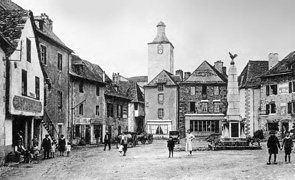
The square we see today only dates back to the early 20C, when the village got a facelift. It was formerly occupied by a block of old houses, surrounded by two streets, which would be knocked down in the early months of 1920.
In 1930-31, a final building was demolished, giving the square its current layout.
You can see the 1914-18 war memorial and also the beautiful old hospice building (1927). An 18C wrought iron cross makes its mark.
Know more about place de la mairie
LA PACHA ES FACHA !
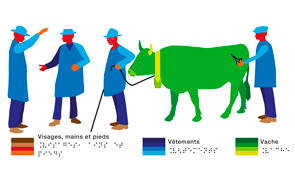
(THE DEAL IS DONE)
From the 16C to the mid-20C, cattle fairs were central to village activity. A 'patche' or slap of the hand was the traditional gesture of livestock dealers. It meant that the deal was struck irrevocably, with no written agreement. On the left of the scene shown below, two livestock dealers are slapping each other's hand. On the right there's a cow attached to a rope held by a man. Using a tool, another livestock dealer marks the animal's hindquarters to recognize it.
Saint-Chély-d'Aubrac
Pont des pèlerins - Pilgrims bridge
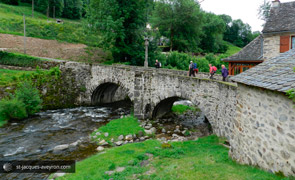
[lo Pònt romiu]
'Throughout the Middle Ages, Santiago de Compostela was the supreme goal for countless thousands of pious pilgrims who converged there from all over Europe. To reach Spain pilgrims had to pass through France and the group of important historical monuments included in this inscription on the World Heritage List marks out the routes by which they did so. »
UNESCO letter of notification sent to the French government on 29 December 1998.
This bridge (known as bridge over the Boralde, or bridge de l'Yeule) is inscribed on the World Heritage List as a property. It is the only point where pilgrims can cross the Boralde without getting their feet wet and has survived in remarkably good condition since the 14C. This bridge is an example of the many structures built to organise a route and to make getting about easier for travellers such as pilgrims or inhabitants in their daily life.
The bridge is a strong symbol in the Catholic faith: a symbol of passing from earth to heaven, hence the frequent presence of a cross on these structures.
Know more about the pilgrims bridge
Architecture
15 m long and 4.6 m wide, it has a gradient of about 8%. The 0.5 m parapets give way to a 3.60 m bridge floor whose paved road, made of boralde river pebbles, was redone to replace the tarmac and give the bridge its original appearance back.
The two arches are separated by a strong, 2 m-thick pillar, protected upstream by a triangular cutwater.
The masonry work is an alternation of vacuolar basalt (lava stone) for the main elements (cornerstones of the piers, arches, top of the parapet, ornaments, etc.) and gneiss used to fill in the walls.
See upstream plan and elevation of the bridge
ROADSIDE CROSS Géolocalisation
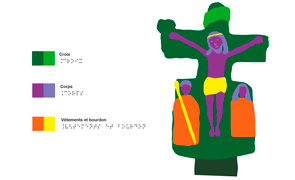
The basalt cross adorned with figures and foliage, which rests on the cutwater of the bridge's central pillar, dates from the 15C-16C. It is quite crude and shows Christ on the cross in its upper part. At his feet: the Virgin Mary (right) and John the Apostle (left). At the bottom of the shaft is a pilgrim, carved in the round. He is wearing the typical long hooded cloak of pilgrims. Portrayed standing and face on, he occupies a rectangular space. In his right hand, he is holding his walking staff and in the left, he is saying the rosary which is placed in front of him.
Saint-Chély-d'Aubrac
The wash house
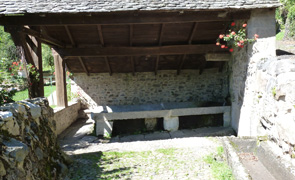
Before the advent of the washing machine, women used to come and wash their clothes here [far la bugada]. The upstream basin was for rinsing.
This chore was probably made easier by the chatting and gossip that ran rife and the place had a really social function.
It was in this area that traces of human occupation in Neolithic times were discovered. The proximity of the spring, which feeds the wash house, backs up the theory of an old settlement..
Saint-Chély-d'Aubrac
The mil of Fabbras
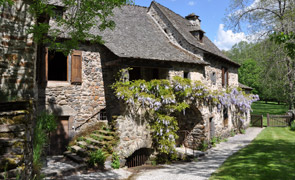
[lo molin de Fabràs]
The old flour mill brought about a revolution at the beginning of the 20C with the installation of a small power plant. The village was then able to enjoy the comfort of electricity very early on (many villages in Aveyron only had access to it from the Thirties and sometimes much later for the remote hamlets and farms).
Private property, no entry to the public.
The building can be seen a few metres further.
Saint-Chély-d'Aubrac
Viewpoint
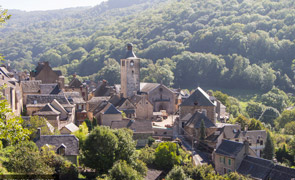
The urban structure of the village is clearly distinguishable, with an extension created from the banks of the Boralde (medieval part) towards the current centre (Place de la Mairie), and then Avenue d'Aubrac (early 20C) and the recent extensions.
Saint-Chély-d'Aubrac
The village of Saint-Chély d'Aubrac

[lo vilatge de Sant-Chèli]
The first written mention of the village dates back to 1082*, but signs of a settlement going back 3,400 years before our time (sharpened flints and planted stakes) have been found. The medieval village, probably surrounded by walls, was spread out over the lower part, from the Boralde to Rue du Château [carrièira del Castèl]. The establishment of a priory was instrumental in the village's rapid development. The regular trading links established with the prosperous Domerie d'Aubrac would strengthen its importance. Before 1552, Saint Chély d'Aubrac had two livestock fairs** to which merchants travelled from the whole of Languedoc and Spain.
There was also a very active craft industry with many weavers who treated the wool coming from the plateau, tanners
Did you know that two of the seven sections of the Route to Santiago de Compostela in France inscribed on the World Heritage List are in Aveyron? There are also four bridges inscribed and Sainte Foy abbey-church in Conques. This represents a remarkable heritage which stretches out over 80 km, from the Aubrac plateau to the Lot Valley. A flow of pedestrian travellers has carved out its path in this landscape.
The Routes to Santiago de Compostela are both unique and universal: they have been fashioned for over 1,000 years in step with feelings, chance encounters and a sense of sharing.
(hence the nickname Pelatièrs [related to the French word for hide] given to the inhabitants of Sant-Chèli and the presence of calquièiras or tanning drums in the cellars of certain houses), and blacksmiths among other activities that were able to set up here thanks to the presence of the River Boralde; these craftsmen gave the place its identity.
At the beginning of the 20C, Saint-Chély-d'Aubrac was a prosperous little town. Evidence of this can be seen in the large buildings on Avenue d'Aubrac, but also in the many shops of which we see signs in the village today (painted shop signs on walls, stalls converted into garages or houses). The following years would be more difficult:
rural exodus, the disappearance of small skilled trades, the draw of the town have meant that today the village only has 250 inhabitants.
* The Bishop of Rodez donated the church of Saint-Chély-d'Aubrac to the Abbey of Saint Victor in Marseille. Along with Saint Urcize and Nasbinals, it was one of the first priories on the Route to Santiago de Compostela in Aubrac.
** The present cattle market [fièiral] is on this square. At the end of October, this is where the Aubrac cattle breed competition takes place.
What’s in a name?
There are two opposing concepts regarding the origin of the name. For some people, Saint Chély d'Aubrac apparently comes from a distortion of Saint Hilaire, for others it comes from sanch Eli (Saint Eloi in Occitan), who is also the patron saint of the parish. As for the inhabitants of Saint Chély d'Aubrac, they have only had a name since 2009: they are called the Saint Chélois.
In Occitan, besides the nickname Pelatièr, they have always said un or una Sant-Chèli. Simple... and beautiful.
Tourism and handicap
Two touch tables for the visually impaired can be found Place de la Mairie (figure 1 on the map) and beside the Pont des Pèlerins (Pilgrims' Bridge) (figure 9 on the map). Because the streets are steep, points 5, 7 and 9 are not easily accessible to people with reduced mobility. Vehicles can stop close to the Pont des Pèlerins (Pilgrims' Bridge/pont romiu).
The pilgrimage to Santiago de Compostela
In the pious Middle Ages, making a pilgrimage to a holy place, and the relics of the martyrs this place housed, was an essential deed in the life of a believer.
The relic of a saint perpetuates his presence and his favourable influence. It provides protection, cure, succour and so on.
Saint Peter, Saint Paul, the first Christian martyrs in Rome, the sites of Christ's life and passion in Jerusalem, attracted pilgrims from all over the Christian West. Around 830, the relics of the apostle James, beheaded by Herod in Palestine in 44 A.D. were miraculously discovered in Compostela (Galicia, Spain). The difficulties encountered by Christians to make their way to the Holy Land, together with the symbol that James the Apostle represented in the Reconquista*, drew the West's attention to this tomb that became one of the major pilgrimages right from the end of the first millennium. Thousands of pilgrims, kings, bishops and ordinary men carried out the journey to Galicia to meditate at the tomb of one of Christ's closest companions.
Four symbolic routes epitomized the countless routes that pilgrims converging on the Pyrenees used to follow. As they wended their way, they visited the many sanctuaries and called upon a litany of saints. They fulfilled their devotions and found charitable assistance.
Their routes played an essential part in trade and religious and cultural development during the Middle Ages.
The many buildings and places of worship that lined these routes are still evidence of that today.
* Reconquest of Muslim kingdoms on the Iberian Peninsula by Catholic rulers between 718 and 1492.
The Route in Aveyron
In 1998, the 'Routes of Santiago de Compostela in France' were inscribed on the World Heritage List because of their exceptional universal value.
This inscription took the form of a selection of 71 buildings and 7 stretches of the way which bore witness to the routes and places frequented by pilgrims wanting to go to Santiago de Compostela. In Aveyron, several edifices are recognised as World Heritage because they are outstanding landmarks on the route followed by pilgrims: the bridges over the Boralde in Saint Chély d’Aubrac, over the Lot in Espalion and Estaing and over the Dourdou in Conques; Sainte Foy Abbey-church in Conques, a place of pilgrimage in its own right dedicated to young Sainte Foy. Pilgrims on the Way of St James, referred to as jacquets, were advised to visit it as early as the Middle Ages;
- Nasbinals (Lozère) / Aubrac / Saint-Chély-d’Aubrac : 17 km from the Aubrac plateau to its foothills; Saint Côme d’Old / Espalion / Estaing: 17 km along the Lot Valley.
Facilities for you
Between Aubrac and Conques, the local authorities of the area that the Puy en Velay route to Santiago de Compostela (GR®65) runs through have carried out a series of developments to help you discover this pedestrian and cultural route that is laden with meaning and history. Information boards line the 80 km section of the route. They will provide you with the tools to discover the heritage that is visible from the route (Romanesque monuments, landscape, geology, rural life, etc.)
A multimedia application (to download free of charge to smartphones and tablets - see below) helps to guide you and give you information about services (accommodation, food, visits, etc.).
You will find extra information on the elements to discover.
Facilities have also been designed for the safety and well-being of users: picnic areas, waterless toilets, footpaths alongside roads, signposts, path maintenance, etc
The GR® and how to use it
The greatest care is taken to maintain the route and to welcome you in our villages so that the walk is a pleasant one for you. Nevertheless, you are responsible along the way.
Please take your rubbish away with you. There are lots of litter bins and toilets along the route.
The best way to observe nature is to respect it (no loud noises or shouting, avoid walking in big groups, etc.). Do not pick flowers, do not disturb the wildlife and herds of livestock. Respect fencing and private property.
Even on foot, please abide by the Highway Code. Warning: in foggy weather, some routes may be dangerous. Start when the fog has lifted or walk along the side of the roadway.
The route is a way to open up to nature, the life of the inhabitants and the traditions and history of the towns and villages you go through:
the people of Aveyron invite you to share their convivial way of life, be curious and feel free to talk to the people you meet!
Information : Tourist Office: 05.65.44.21.15 or 05.65.44.35.94 / www.aubrac-laguiole.com
Comité Départemental du Tourisme de l’Aveyron (Aveyron Tourist Board) : www.tourisme-aveyron.com
Did you know that two of the seven sections of the Route to Santiago de Compostela in France inscribed on the World Heritage List are in Aveyron? There are also four bridges inscribed and Sainte Foy abbey-church in Conques. This represents a remarkable heritage which stretches out over 80 km, from the Aubrac plateau to the Lot Valley. A flow of pedestrian travellers has carved out its path in this landscape.
The Routes to Santiago de Compostela are both unique and universal: they have been fashioned for over 1,000 years in step with feelings, chance encounters and a sense of sharing.
UNESCO World Heritage
The year was 1945. The world was awakening from a nightmare that had gone beyond the bounds of horror. On 16 November, the United Nations Educational, Scientific and Cultural Organisation (UNESCO) was set up by the League of Nations.
Its aim: to build peace in the minds of men through education, science, culture and communication in order to further universal respect for justice, the rule of law, and human rights along with fundamental freedom for everyone, regardless of race, gender, language or religion. The 1972 Convention concerning the Protection of the World Cultural and Natural Heritage served UNESCO's ideal of peace and dialogue. Inscription on the World Heritage List consists in identifying, protecting and preserving, throughout the world, the cultural and natural heritage deemed to have exceptional universal value.
World Heritage sites belong to all the peoples of the world. There are currently nearly 1,000 'Properties' in 160 countries inscribed on the World Heritage List. France has 38 inscribed Properties.
Saint-Chély-d'Aubrac
Street Tralfour
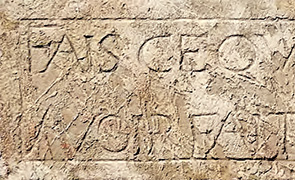
This street gets its name from the old communal oven [tras lo forn: meaning behind the oven in Occitan].
It was the main shopping street [carrièira] in Saint Chély d'Aubrac and had a cobbler [sudre, pegòt], a grocer's (the village
had five of these!), a milliner [capelièr], a haberdasher, a butcher's – that used to use the old communal oven as a slaughterhouse [masèl] - and later a baker's and an electrician.
It has an unusual feature: the inscription «Fais ce que tu voudras avoir fait quand tu mourras » (Do what you would like to have done when you die) (1629), engraved in the front wall of the house where the former grocer's used to be.
It is most probably linked to the plague epidemics that the region experienced at that time.
Saint-Chély-d'Aubrac
The church
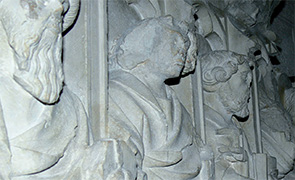
In 1385, the old church (mentioned back in 1082) was set fire to by rovers who pillaged the village (Hundred Years' War).
It was rebuilt at the beginning of the 15C on the initiative of the Dom d'Aubrac. Its steeple bears the signs of the watchtower (arrow slits) on which it was erected. The pointed barrel vault – modelled on the Domerie d'Aubrac – is reinforced by large transverse arches, made of volcanic tuff, which mark out the bays.
The furniture is quite exceptional for such a plain building. The 18C main altar was restored around 1860 by the painter Castanié, who also did the copy of Rubens' 'Descent from the Cross' and the half-relief showing the Eternal Father and the tabernacle.
The side niches are decorated with gilded statues of Saint Roch and Saint Éloi (patron saint of the parish). The second chapel, on the right, has two paintings showing presentations
of the Rosary by Lemaire (17C), but the showpiece has to be two fragments of limestone bas-relief (first half of the 14C), portraying Christ and seven of his apostles, including James the Great, carrying the staff of pilgrims on their way to Galicia and the big hat with the shell on it.
This very fine piece was exhibited at the Louvre in 2009, as part of the exhibition called 'Early altarpieces - A presentation of sacred art'
Saint-Chély-d'Aubrac
The tower
This tower was built around 1475 by Pierre de Cusinis, a judge in Aubrac. It gave added protection to the village that had been hard hit by recent forays by pillagers. Up until the Revolution, it used to house the religious congregation of the Frères de Cusinis. It became state property and on 28 April 1791 was sold to the surgeon in Saint Chély d'Aubrac.
Opposite the rear of the tower, an 18C building is home to the Tourist Office.
There are some lovely vaulted rooms and a former dungeon to be seen there.
Saint-Chély-d'Aubrac
The new Saint-Chély d'Aubrac
The large buildings on Avenue d'Aubrac date back to the beginning of the 20C.
They mainly owe their existence to people who were born in Aveyron coming back there from Paris.
Seasonal emigration existed since the early 19C, and even before that, but it was from the end of the 19C that people of Aveyron left a land that could no longer provide for their needs in droves.
The Parisian 'network' got organised for people from North Aveyron.
Carrying out the toughest jobs (they were the ones to deliver coal, but also worked as water carriers, scrap merchants, coach drivers, etc.), they managed, by dint of solidarity, hard work and savings, to set up small 'cafés-charbons', then cafés-brasseries* that would often be among the most famous in Paris**.
They also helped to safeguard traditions such as playing the cabrette [cabreta], dancing the bourrée [borrèia] and playing quilles [quilhas].
When returning to their village on holiday, or for well-deserved retirement, they built large houses and contributed to the economic life of this whole region.
* Along the lines of the many small cafés in their villages.
** Brasserie Lipp, Café de Flore, Les Deux magots, Le Dôme, Café Costes, among others...
People from Aveyron in Paris
Le Point magazine Anne-Sophie Jarrige
They come from Laguiole, Entraygues, Espalion, Saint Geniez d'Olt or Millau. Like Jean Valjean [one of the main characters in Hugo's Les Misérables], they arrived in Paris penniless and with a vague dream of turning their green mountain into a mountain of gold. How are they recognized? By a slight Southern French accent which, suddenly, lights up their dark clothing like a stormy sky. These are the Aveyron people of Paris. Bar, café and restaurant owners, but also doctors, teachers, cardinals or ambassadors, they all belong to that once mocked migrant population, confined to the ghetto of the Bastille district, which managed to fit in at every level of Parisian society.
Just how many of them are there? Nobody really knows. The most frequently advanced figure is 320,000. There are apparently between 5,000 and 6,000 Parisian cafés, hotels and restaurants in their hands, along with 70% of the tobacconists'. One thing is for sure: there are more natives of Aveyron in Paris today than their compatriots still living in the actual département which only has 260,000 souls.
Their story began a hundred and fifty years ago. At that time, Aveyron, a county undergoing massive change, experienced unprecedented economic losses. In rural areas, the farm was no longer enough to feed the family. Siblings had to leave. The first went with their livestock to the slaughterhouses of La Villette. The ones who followed were quickly taken on as water carriers, dairymen, coach drivers or scrap merchants.
This flow of migrants has run dry today. 'Young people nowadays come to Paris to study and not to make a fortune, says Muriel Harel, a journalist on L'Aveyronnais de Paris. They've seen their parents or grandparents slave away and they don't want to do the same.' Especially since there are now more jobs back home (the unemployment rate in Aveyron is one of the lowest in France – 5.4% compared with the national average of 12.7%). And then, 'when most people are on a 35-hour working week, jobs in the catering trade have less appeal', recognizes Maryvonne Leparmentier, head of the Cité des Fleurs hostel for young workers (50% occupied by people from Aveyron), in Paris's 17th arrondissement, which is now home to more computer analysts and office workers than waiters.
However, bars, hotels and restaurants are still the showcase of Aveyron in Paris. Les Deux Magots, Les Trois Marches, Le Wepler, L'Escurial, Brasserie Lipp, Café de Flore, Café Marly, and Le Dôme are still symbols of success. Admittedly, it's often the third or even fourth generation which is today at the head of these empires. But the stock career of the perfect bar owner has not changed: you always start as a waiter, you then go on to become a salaried manager and then a manager before buying your own business, which you sell for a bigger, better located one.
The Costes brothers, who now own some thirty establishments in the capital, began like this: Gilbert, current presiding judge at the Paris Commercial Court, used to serve aligot at L'Ambassade d'Auvergne when he was 20, whilst his younger brother, Jean-Louis, used to draw beer at La Strasbourgeoise. A spell in well-known restaurants (Plaza-Athénée, Ledoyen, etc.), some rudimentary accounting skills and they ran their first business: Le Ronsard, at the bottom of Montmartre, for Jean-Louis, and a tobacconist's at place d'Orléans for Gilbert. The money-making machine, however, didn't really get off the ground until the first Café Costes, designed by Philippe Starck, was created in 1979 in Les Halles district.
Sicilian solidarity
What's their strategy? It can be summed up in a few words: stubbornness, mutual aid and discretion: three virtues typical of Aveyron. To put it plainly, a passion for the job and for quality, unremitting effort from dawn to dusk, and of course the location. 'It's of utmost importance', insists Bernard Lhéritier, a native of Entraygues, who preferred to leave the business he had at Place Voltaire - 'a lacklustre neighbourhood' in his opinion - to come and set up alongside Chez Angelina, opposite the Jardin des Tuileries, at the Rivoli Park Tavern.
Because the new bougnats as they were called no longer run bistros, they liven places up and create atmospheres. What's their recipe? Nobody will tell you straight up. 'We see to it that people feel good', says Andrée Bouert at the Auberge Aveyronnaise, by offering authentic products in a warm and welcoming setting.
Such is Jean Richard's credo too. Close-cropped hair, impeccably pressed black suit and a grating accent, the youngest of the famous wine merchants today runs nine restaurants and a hotel in the 7th and 8th arrondissements of Paris, including Chez Francis, Marius et Janette, Avenue George V and the Berkeley on avenue Matignon. 'I couldn't care less about fashion, he explains seriously. I only care about the quality of my products.' »
The active support of suppliers (the well-known RTL – Richard, Tafanel, Ladoux -, but also Bertrand, all of Aveyron or Cantal origin) has also played a part in these success stories. 'The reps do their rounds in the various establishments. They know everything that goes on, recognizes Bernard Lhéritier. They help us to get on.' If the boss is trustworthy, the distributor won't think twice about helping him financially, standing surety or even, when he's setting up, providing him with draught beer dispensers or coffee machines free of charge – gifts that can amount to 6,000 euros. If, as anticipated, the new owner is up to the task, everyone will be a winner: the new boss and the broker, who will have got himself someone who is obliged to carry on getting supplies from him.
'We are very close to our customers, says Anne Richard, Pierre's daughter, who looks after the marketing for the café sector today. Our deliverymen often act as confidants or advisors to our customers, when they're not stepping down into the cellar to sort out the way the wines are put away!' With the monopoly on wine distribution in the capital, it's in Maison Richard's interest to keep alive this solidarity that some people will describe as Sicilian but without the guns! This family empire stretches from Draguignan in the southern French Var to London. That accounts for turnover of 61 million euros, 1,800 wine and spirit references, 14,000 customers and 11 subsidiaries outside Paris. But also 600 hectares of vineyard and 12 domaines divided up between the Bordeaux region, the Beaujolais and the Rhone Valley, with Château La Nerthe (Châteauneuf du Pape) and Château Le Bourdieu (Haut Médoc) being their finest flagships.
Berthillon and Maury
But the success stories don't just stop at cafés and bars. Berthillon, the famous ice-cream maker on rue Saint Louis en l'Ile in Paris, discovered by Gault et Millau in 1964 and who today turns over 3 million euros, without any marketing, is from Aveyron.
The Aveyron label has also done wonders in the fashion industry: Bernard Perris, for example, was assistant to Guy Laroche and Jean-Louis Scherrer's couturier. Tartine et Chocolat and Un dimanche dans nos campagnes also have their roots in Aveyron. The same goes for clothing range Bonpoint. The famous smocked dresses and apple green striped t-shirts have been designed since 1973 by a native of Aveyron, Marie-France Cohen, the sister of Annick Goutal who has made a name for herself in perfume. With its wealth of cousins, sons-in-law, nephews, parents and other relatives, the family, originally from Laguiole, today controls some thirty shops in Paris. As has always been the tradition in Aveyron, families work together. Bernard Cohen takes care of the money and admin side, Dominique Swidens, Marie-France's sister, is a designer like her; Juliette Swidens, Dominique's daughter, looks after 1 et 1 font 3, a clothing range for pregnant mums. As for the Cohen children, they have recently opened a boutique for accessories, Bon Ton on rue de Grenelle.
Another sector is printing. Originally from Millau, Jean-Paul Maury is at the head of one of the biggest printing houses in France. With 30% of the rotary offset market in France, it employs 1,550 people and has turnover of 20 million euros. It prints 175 weeklies or monthlies including Le Point, L'Express, Paris Match, France Football and Santé Magazine, some of the Reader's Digest publications for England and Belgium, bibles for the whole world and the Michelin guides.
Symptomatic of this professional diversification is the Association Auvergne Business Club (AABC), set up some ten years ago. Who are the members? Executives, company directors, academics, lawyers, directors of L'Oréal, Crédit Agricole or BNP Paribas to name but a few. In total, a hundred members, all rock solid and who have not disowned their origins once arrived in the capital. They get together around a good meal, call each other up, give each other a helping hand and apply a preference for all things Aveyronnais. Maybe to atone for having left their region?
Saint-Chély-d'Aubrac
On the route of Santiago de Compostela in Aveyron

[pel camin romiu roergàs]
The 17 kilometres from Nasbinals to Saint Chély d'Aubrac are inscribed on the World Heritage List under the 'Routes of Santiago de Compostela in France'. This property consists of a selection of 71 buildings that are illustrative of the pilgrimage and prayer. It also includes seven sections of the Via Podiensis starting from Le Puy en Velay, in other words 160 km of the 730 km of the journey.
These 'sections of path' are exceptional because they have kept some of their original appearance. Alongside the bridges, religious buildings and hospices, they bear witness to the essential role that the Routes to Santiago de Compostela played in trade and religious and cultural development during the Middle Ages.
In Aveyron, two sections are concerned:
- Nasbinals (Lozère) / Aubrac / Saint Chély d'Aubrac: 17 km from the Aubrac plateau to its foothills.
- Saint Côme d'Olt / Espalion / Estaing: 17 km along the Lot Valley. The village of Saint Chély d'Aubrac also has a monument included in the Property: the Pont des Pèlerins (Pilgrims' Bridge), over the Boralde.
Unesco World Heritage Géolocalisation
In 1945, the world was awakening from the nightmare of war.
On 16 November, the United Nations Educational, Scientific and Cultural Organisation (UNESCO) was set up by the League
of Nations. Its aim: to build peace in the minds of men through education, science, culture and communication in order to further universal respect for justice, the rule of law and human rights along with fundamental freedom for everyone, regardless of race, gender, language or religion.
The notion of world heritage is more recent (the 1972 Convention concerning the Protection of the World Cultural and Natural Heritage). It consists in identifying, protecting and preserving, throughout the world, the cultural and natural heritage deemed to have exceptional universal value.
There are currently nearly 1,000 'Properties' in 160 countries inscribed on the World Heritage List, 38 of which are in France.
Nasbinals / Aubrac / Saint-Chély-d’Aubrac Géolocalisation
This section is probably the most captivating in terms of scenery and diversity. It partly follows the routes established prior to the passing through of pilgrims on their way to Santiago de Compostela: Via Agrippa (the Roman road linking Lyon to Bordeaux) and the main drailles [draias] or drovers' roads that were used to take flocks of sheep up to the summer pastures on the Aubrac. In the Middle Ages, these routes changed to rejoin places designed to welcome pilgrims, such as the Domerie d'Aubrac or places of worship.
The current agricultural and social balance globally corresponds to the principles laid down in medieval times, with highly structured trading between the mountain and the surrounding valleys. Regarding the buildings and the landscape, few changes have taken place. Local stone (basalt, granite, gneiss and mica schist) is used for the construction of buildings and low surrounding walls [paredors], summer pastures [pradas, montanhas] alternate with moors covered with heather or broom and forests, and arable land is rare.
The most notable changes concern the replacement of sheep with cattle in the 18C and more forests taking hold on certain slopes.









































